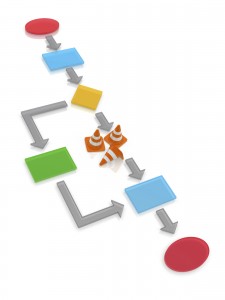Innovation and Collisions

Want me to mash something up?
As I’ve written on several occasions (here, here, and here), mashup thinking is often the driver behind breakthrough innovations. Mashup thinking is not the same as thinking out of the box. Rather, it’s thinking out of several different boxes.
Wheeled luggage is a good example. There’s a box called wheels. There’s another box called luggage. You take an idea from each box, mash them up, and create a third box called wheeled luggage. Now we can select an idea from yet another box called power supplies. We mash that up with wheeled luggage and we get yet another new product: self-propelled wheeled luggage.
Note that the originating ideas (wheels, luggage, power supplies) are not breakthrough ideas in and of themselves. Indeed, they’re rather mundane. It’s only by mashing them up that they become, new, different, and valuable.
How do you promote mashup thinking in your organization? The simple answer is collisions. You need to get people, ideas, and concepts to collide. Think of it as an atom smasher. When two atoms collide at high speed, they produce a very interesting array of new particles. You want to produce similarly productive collisions in your organization.
Here are some tips on creating productive collisions:
Diversity – let’s say you get two engineers to collide. That’s interesting but not usually productive. After all, they’re in the same box. The trick is to get two people from different boxes to collide. That requires diversity. This includes ethnic and geographic diversity. Some very innovative companies have found that putting together people from, say, Africa, Europe, South America, Japan and the USA can produce very interesting results. Age diversity – old people mixed with young – can also create productive collisions. For me educational diversity is equally important. Indeed, I tell my clients that one of the reasons they should hire me is because I don’t have an MBA. I think differently.
Seating arrangements – why do so many companies put engineers in one area, marketers in another, finance people in another and human resources folks in yet another? That practically guarantees that all collisions will be same-box collisions. Randomize your seating chart. You’ll be surprised.
Architecture – the way you organize your space can either promote or prevent collisions. Fewer bathrooms, fewer coffee stations, and fewer lunchrooms all promote collisions. Rather than providing lots of places to congregate, offer fewer. You’ll get larger congregations.
Policies – earlier this year, Marissa Mayer of Yahoo! announced that employees would need to come to the office. No more working from home all the time. The policy got a lot of pushback. But I’m sure that it also produced a lot more collisions.
Innovation and Symbioscience

Place two ideas here. Then press “mash”.
What’s so hard about wheeled luggage? We’ve had wheels for thousands of years. We’ve had luggage for thousands of years. These are not exotic, leading-edge concepts. Yet it took us thousand of years to put wheels on luggage. I remember when it happened. I slapped my head and thought, “What took us so long?”
Part of the problem is that we think too big. When we want to think outside the box and get creative, we often aim for something truly revolutionary. We’re looking to change the world. We don’t think of mundane things like wheels and luggage. Yet, the people who did put wheels on luggage certainly made my world more convenient.
Putting wheels on luggage is generally known as mashup thinking. We mashup two or more things or ideas to get something new. As it happens, a significant portion – perhaps a majority – of our most important innovations result from mashing things up. If you mash up x-rays with computer processing, you get CT scans. Mashing up a mobile phone and a tablet yields a “phablet” like Samsung’s best-selling Galaxy series. Mashing up multiple (government sponsored) technologies yields the iPhone. Mashing up a flywheel and a bicycle yields the Copenhagen wheel. The wheel stores energy as you bike along and releases it when you need some extra power.
The problem is that we just don’t think about mashing stuff up. We’re too busy pushing the envelope. We want something shiny, bright, and new. Not something composed of old – perhaps very old – technologies.
Rosabeth Moss Kanter tells the story of a mashup that didn’t happen. Gillette owned Oral B, Braun, and Duracell. You might think that they would mash these up and produce a battery-powered toothbrush. But they weren’t the first to market. Other companies won the race while Gillette lagged behind.
I’ve been looking for companies that do a good job of mashing things up. Companies that are considered to be very innovative – Apple, Samsung, Google – may fit the bill but I’ve also been looking for “mere mortal” companies. In other words, companies that we might reasonably be able to emulate. Then one of my students alerted me to Mars.
I think of Mars as a chocolates and sweets company. It turns out they do a lot more. In fact they have six different brand clusters: Petcare, Chocolate, Wrigley, Food, Drinks, and Symbioscience. It was Symbioscience that caught my eye. According to its website, “Mars Symbioscience acts as an incubator for business ideas generated throughout our segments … “ Further, it’s “a technology-based health and life sciences business focused on evidence-based product development.”
Mars Symbioscience has already developed products (and brands) in three different segments: Petcare, Plant Care, and Human Healthcare. I’m not an expert on these categories but I’ve reviewed the products on the Mars website and I’m willing to bet that mashup thinking was part of the process.
Mars Symbioscience seems to be a good example of a company that dedicates resources to innovation and mashup thinking. How do they do it? More on that in the near future.
(By the way, I’ve never met the student who brought Mars Symbioscience to my attention. He lives in San Antonio and takes my online classes, which are a mash up of college education and the Internet.)
(By the way (2), I’m looking for other good examples of companies that do mashup thinking. Please pass along any examples you’re familiar with.)
Innovation: Signals and Processes

It’s a process.
Innovation is a two-part process. First, we need to create ideas. Second, we need to take those ideas and convert them into something practical and useful. In some ways, creating the idea is the easy part.
Too often, our efforts to innovate focus on one or the other but not both. We may develop lots of ideas on how to be more creative. Yet, creativity without discipline usually doesn’t produce innovation. The reverse is also true. Disciplined implementation processes don’t produce innovation unless we can feed creative ideas into the system.
One way to think about this is to understand the differences between signals and processes. To create innovative organizations, we’ll need both. Signals are about culture. Processes are about decisions.
Many organizations don’t actively foster innovation. They may talk about innovation but the culture doesn’t seek out and promote new ideas, new products, or new ways of doing business. The culture may be innovation resistant; it actively opposes change. Or it may simply be innovation neutral; it doesn’t oppose change but nor does it promote it. Change is hard. To succeed, the culture needs to actively foster change, not merely be neutral to it.
Let’s say we want to change our culture to actively promote change. That’s where signals come in. A signal lets our employees know that we’re changing our attitude toward change. Signals may be simple and obvious. It could be the way employees dress – Birkenstock Fridays! It could be the way work is organized – hackathons! It could be as simple as changing the seating chart or the lighting level or where the coffee stations are located.
Signals are useful but not sufficient. We also need processes that are baked into the culture. Let’s assume, for instance, that our new culture (with its new signals) creates lots of good ideas. Now we need a set of decision processes for evaluating new ideas and deciding which ones to invest in. As Rosabeth Moss Kanter points out classic financial metrics (ROI etc.) probably don’t apply. Classic financial metrics require predictability. Innovations aren’t predictable. We’ll need new processes.
Processes are useful but also not sufficient. You need processes to make the decisions to get the innovative work done. But you need signals to let people know that innovative work is acceptable and encouraged – and that new processes are emerging. As always, it’s the balance that counts.
Digitizing The Enterprise
 McKinsey recently published a survey of 850 C-level executives regarding their views on digitizing the enterprise. McKinsey asked about five major trends: 1) big data and analytics; 2) digital engagement of customers; 3) digital engagement of employees and partners; 4) business-process automation; 5) digital innovation.
McKinsey recently published a survey of 850 C-level executives regarding their views on digitizing the enterprise. McKinsey asked about five major trends: 1) big data and analytics; 2) digital engagement of customers; 3) digital engagement of employees and partners; 4) business-process automation; 5) digital innovation.
What do C-level executives think? Of the five trends, customer engagement is clearly top of mind today. Over half the respondents (56%) say that engaging customers and finding new customers through digital channels is at least a top ten priority.
Indeed, digital engagement is accelerating. Compared to the same report in 2012, companies are increasingly using digital techniques to: maintain brand consistency across channels, identify and advertise to target customers, make personalized offers, engage in social media, and create branded applications (and games) for mobile devices.
Big data and analytic initiatives are also growing. Executives report they are especially focused on analyses that help improve forecasts and planning processes. In general, big data activities focus mainly on growth and enhancements – growing revenue, for instance, or enhancing customer service. Using big data to reduce costs is much lower on the priority list.
Similarly, the next wave of business-process automation focuses primarily on efforts to improve quality or create new digital capabilities. Relatively few process automation projects are targeted at reducing cost or replacing labor.
Digital innovation activities revolve around improvements rather than entirely new product categories. Some 40% of respondents say they are adding digital capabilities to existing products or enhancing their technology stacks – by adding cloud computing, for instance.
Of the five key trends, digital employee engagement seems to be the least well developed. Executives report that they use digital tools for employee evaluation and feedback. By and large, however, they’re not engaging in more advanced applications like collaborative design and knowledge sharing.
CEOs are also becoming more involved in digital initiatives. In the 2012 survey, both the CIO (26%) and the CMO (25%) were more likely to be leading digital initiatives than was the CEO (23%). In 2013, the tables turned with CEOs (31%) leading the way while CIOs and CMOs stayed about the same (both at 26%). CFOs lagged far behind – 12% in 2012 and 13% in 2013.
There’s also a new C-level executive at the table – the Chief Digital Officer or CDO. Some 30% of the respondents say that their companies now have CDOs, often with “cross-cutting responsibilities for all digital activities”. Those companies with CDOs claim to have implemented more of their digital vision than those without.
Overall, the executives are quite optimistic about their digital initiatives. Nearly two-thirds (65%) expect that their digital projects will improve operating income over the next three years. Interestingly, B2B executives are more optimistic about growth potential than their B2C counterparts.
While two-thirds of executives foresee growth in income due to digitization, one-third don’t. The more pessimistic executives fear that they won’t be able “to adequately respond to changing customer behavior and expectations”.
Executives admit that they’re only roughly one-fourth of the way toward their ultimate objectives. Still, they’re quite bullish on digital initiatives as ways to transform their companies and their markets. If they can manage three key obstacles: leadership, expectations, and talent management – they see a bright future for their digital enterprises.
Where You Stand Depends On Where You Sit

Stand by me.
I walk our dog, Bella, two or three times a day. I enjoy it almost as much as she does. I’ve also found that walking a dog is a great way to meet people. (If only I had known when I was single). It’s nice to meet the neighbors. But what’s frightening is that we all think alike.
As Bill Bishop pointed out in The Big Sort, we’ve sorted ourselves out by political viewpoints. Republicans live in Republican neighborhoods and Democrats live with Democrats. We don’t mix and mingle much. When we meet people, we tend to hear things that confirm rather than challenge our views. We live in echo chambers. Tom Friedman calls these monocultures as opposed to polycultures.
Monocultures can make you crazy. If you only read and hear ideas that you agree with, you’ll only reinforce pre-existing connections in your brain. You won’t create new connections. From everything I’ve read, the brain thrives on connections. The more, the merrier. Tom Friedman writes that polycultures are much more sustainable than monocultures. I suspect that a polycultural brain is much healthier than a monocultural brain.
We also know that mashup thinking is one of the best ways to stimulate innovation. You take ideas from different boxes and mash them up. This is not out-of-the-box thinking. It’s multiple-box thinking. Take X-rays and mash them up with computer processing and you get CT scans. Take phones and mash them up with computers and you get smart phones. Take MTV and mash it up with cop shows and you get Miami Vice.
The more we have monocultures, the less we’ll have mashups. The more we talk to people just like ourselves, the fewer innovations we’ll have. It’s by putting different things – products or ideas – together that we get innovation. We all have partially formed ideas. Only by interacting with people who have complementary ideas can we develop bright new innovations. (I suspect this is why Apple recently hired Angela Ahrendts from Burberry).
Given all this, I’m constantly amazed that companies deliberately create monocultures throughout their facilities. Engineers sit with engineers. Finance folks sit with finance folks. Marketers sit with marketers. Each little zone is a monoculture. People with the same outlook, backgrounds, education, and conditioning sit together. They don’t talk to people with complementary ideas. They talk to people with the same ideas.
If you want to stimulate innovation in your company, mix it up a bit. Even a random seating chart is probably better than a department-by-department arrangement. Group people with different interests and backgrounds together. Then change it every now and then to establish new patterns and innovative connections. Just remember, where you stand depends on where you sit.